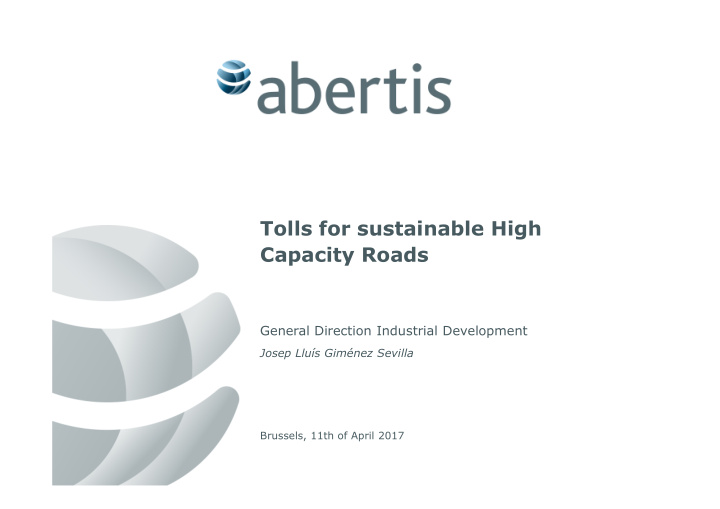



Tolls for sustainable High Capacity Roads General Direction Industrial Development Josep Lluís Giménez Sevilla Brussels, 11th of April 2017
Content 1. Abertis Introduction: Industrial Model 2. “Pay per use”: A model for sustainable infrastructures 3. Benefits of ETS Free-flow systems: Towards a seamless road charging system
1 1. Abertis Introduction Our Industrial Model
1. Abertis Introduction World leader in the toll road market Abertis is the leading international group of toll-road operators 41 concessions 16 countries 8,500km managed 16,000 employees >1 Bn€ CAPEX/yearly 25 Bn€ assets managed General Direction Industrial Development 4
1. Abertis Introduction Industrial Model: a balance between smart engineering and sound financial Abertis is a long-term Investor Social Customer Responsibility Satisfaction Strategic areas Governmental Entities Employees Relationship Our Industrial Model is based on: � Respect for the contract: our reason why � Customer service: adding value to the customers � Road engineering: safe and comfortable roads � Intensive technology: ETC and ITS Efficient operations: viability, fluidity and CAPEX and OPEX optimization: economic � � services control General Direction Industrial Development 5
1. Abertis Introduction World leader in the toll road market Grown by being As the global leader in Committed to good partners to our sector, we aim to environmental governments set standards for problems the industry Road Tech: Road Safety as main Providing best Continually investing priority quality in technology and infrastructure smart engineering General Direction Industrial Development 7
1 2. EU Toll Road Market “Pay per use”: A model for sustainable infrastructures
2. EU Toll Road Market Europe Snapshot Paved Road Length 4,77M kms Available budget: just around 70%* Registered cars in use (2015) 195M cars Responsible for aprox. 12% EU CO2 emissions* Toll roads 63.200 kms Privately managed toll roads 22.000 kms ( approx. 34,6% of the total) *Source: EU Road Federation *Source: European Commission. *Source Data: Abertis PPP Country Attractiveness Index (2016). Malta and Luxembourg are excluded. 8
2. EU Toll Road Market EU High Capacity Network and RUC systems C h ar t 6.1 h i g h w ay n et w o r k i n e u r o pe s o u r Ce : i n eCo (2013) General Direction Industrial Development 9 9
2. EU Toll Road Market EU High Capacity Network and RUC systems Chart 5. Road user charging for trucks (HGVs) in 2015 Source: own elaboration (with DGMOVE data) General Direction Industrial Development 10 10
2. EU Toll Road Market Infrastructure financing needs Free infrastructure doesn’t exist TAXPAYERS USER-PAYS Public finance Private finance Which of both affects more P3’s based on payments from P3’s based on payments from public sector to private sector users funding by private the Public subject to compliance financial market, lenders, Deficit? conditions (shadow tolls, investment funds, equity availability payments) CROWDING OUT INEFICIENT LESS CASH TO MARKET EFFECT ECONOMY General Direction Industrial Development 11
2. EU Toll Road Market Breaking up PPPs contract model Contract 1 Contract 2 Contract 3 Infrastructure Operation & Project Design & Planning Maintenance Construction phase Private Sector Private Sector Public Sector Primary (Operation Contract) (EPC) (Engineering) executor Public financing (budgetary User fees Public financing Primary resources) (budgetary resources) funding (toll charges) Resource flow Cash Flow from value operation contract General Direction Industrial Development 12
2. EU Toll Road Market “Pay-per-use” model for financial sustainability of infrastructure European Road Network National High Capacity Roads Metropolitan Area EC to promote “user-pay” and EC to promote “user-pay” and EC to regulate an homogenous toll “polluter pay” schemes, so MS “polluter pay” schemes, so MS systems. Ideally covering: ideally implement: ideally implement: Tolls for HGV distance-based, free- • Tolls for HGV distance-based, Tolls for managing congestion flow, differentiated for emissions. • • free-flow, differentiated for and pollution in metropolitan Promote the roads of the future • emissions, in all the High areas. with ITS, autonomous driving, Capacity Network. Innovation and adaptation to connected vehicles, electric • Alternative routes through optimize mobility, improving vehicles, and additional Services • conventional roads also capacity and efficiency (i.e. (i.e. Truck Park, Cross-docking, regulated to avoid free-riders. managed lanes). etc.). General Direction Industrial Development 13
1 3. Benefits of ETS free- flow systems Towards a seamless road charging system
3. Benefits of ETS Free-flow systems EETS Model Interoperability is key to achieve a real single transport European area, with transparency and no discrimination between European operators . Abertis defends a holistic approach for the successful implementation of an interoperable EETS based on four pillars: Pillars for a successful implementation Figure 1 Source: Own elaboration General Direction Industrial Development 15
Abertis experience Towards Free-flow systems Improvements in Puerto Rico New Gantry Old plaza Old plazas New Gantry Brussels, 9th of December 16
Abertis experience Towards Free-flow systems Accidents in Puerto Rico Brussels, 9th of December 17
3. Benefits of ETS Free-flow systems Why free-flow? New technologies can represent an important investment to improve mobility, safety and environment, and to boost growth LOW MORE SAFER MORE MAINTENANCE SUSTAINABLE EFFICIENT COSTS General Direction Industrial Development 18 18
Thank you for your attention Commitment and delivery
Recommend
More recommend